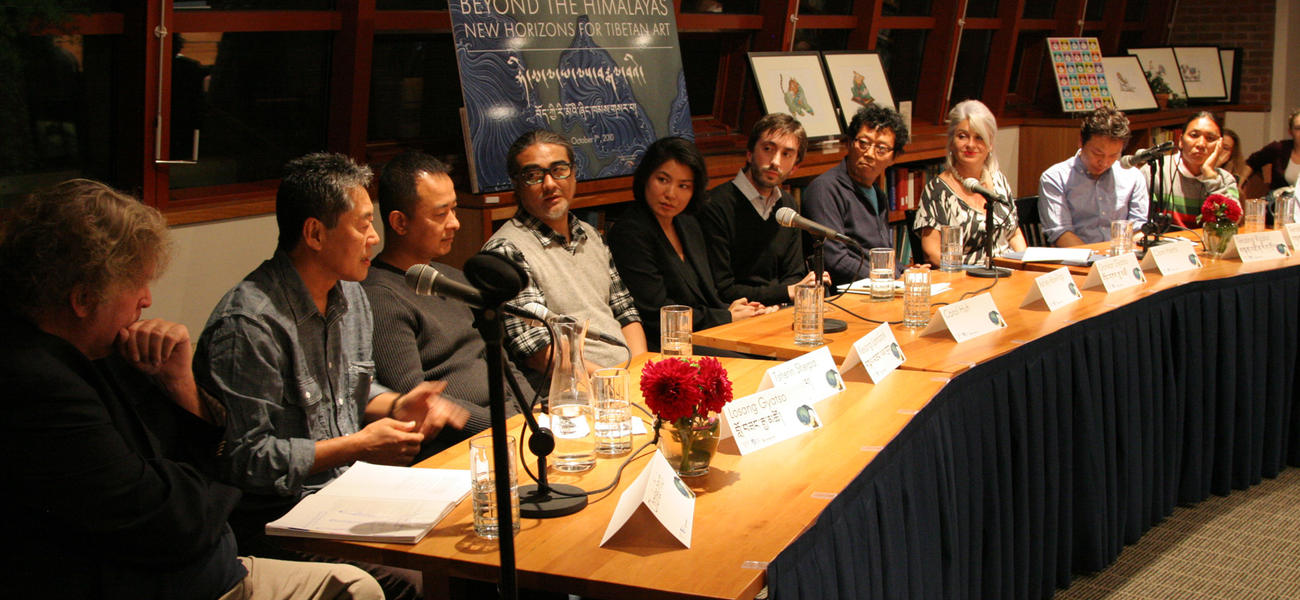On October 7th, Trace Foundation together with ArtAsiaPacific and the Rubin Foundation invited six of the leading contemporary Tibetan artists to discuss the future of contemporary Tibetan art. This roundtable, entitled Beyond the Himalayas: New Horizons for Tibetan Art, was in connection with the closing of “Tradition Transformed” at the Rubin Museum of Art, the first show of contemporary Tibetan art at a New York museum. The speakers included Clare Harris, fellow of Magdalen College, Carol Huh, assistant curator for Asian art at the Freer-Sackler Galleries, and Charlie Finch, senior art critic at Artnet.com, and was moderated by Ashley Rawlings.
I knew little about Tibetan contemporary art, when my editor at ArtAsiaPacific, Elaine Ng, asked me to join a panel on the subject at Trace Foundation in conjunction with the show “Tradition Transformed: Tibetan Artists Respond” at the Rubin Museum in New York. Looking through the catalogue, I was particularly struck by the fantastic paintings of Tenzin Norbu, whose ease of line and sensual monks and dragons would be appreciated in any contemporary art context. When I walked into the Rubin, Tenzin Norbu was there and I embarrassed him a bit by wrapping him in a congratulatory bear hug. The show’s lead curator, Rachel Weingeist, explained to me that even the most tepid use of images from the modern world is radical by the standards of traditional Tibetan art practice. Her criteria for choosing the artists in the show, she explained, was excellence in the craft of making art, primarily and a kind of surrealistic undercurrent that conveyed a subtle, yet respectful, undermining of Tibetan tradition.
Looking at the work of Dedron, the only woman in the show, I was deeply moved by the searching eyes and closed mouths of her childlike figures, and was later disappointed that Dedron did not appear on the Trace Foundation panel. The eight male artists on the panel struck me collectively as physically and spiritually akin to the Abstract Expressionist painters of the 1940s: Gorky, DeKooning, Pollock, Rothko, Motherwell and the rest. They wore the same blue jean outfits as those masters and exuded a physically fit machismo and rough, ironic humor.
Losang Gyatso at 57, the same age as myself and a veteran of Madison Avenue, seemed the most Westernized, yet was firm in his respect for Tibetan traditions, talking about his difficulty in finding a Tibetan woman to marry and subtly chastising my use of the term “transgression,” which he preferred to characterize as “reimaginings.” Kesang Landmark’s work seemed the most akin to the contemporary pieces of Damien Hirst. Kesang’s powerful black skull mandala filled me with foreboding, emphasizing the dark side of nothingness. Yet, he was the most wry and cheerful member of the panel.
Tenzig Rigdol exuded gentleness and compassion, yet his work, such as Updating Yamantaka, in which the goddess of chaos tramples Osama bin Laden underfoot, created turmoil out of traditional designs through collage. Tsherin Sherpa’s elaborate Buddha heads and Pemba Wangdu’s illustrations of the five poisons through intertwined erotic figures are a little off-putting in their complexity for one as ignorant as I am about their messages.
This brought to mind the burdens of the Tibetan diaspora and its destination beyond the concerns of a revered and mind-boggling esoteric Buddhist tradition. Must everything be explained in this body of art to be understood? The artists on the panel are devoted to the peculiarities of their craft and, to my mind, this demanded that they ultimately work on a larger, more public scale in the West. The artists pointed out that the Scorching Sun of Tibet, held this fall at the Songzhuang Art Museum, included larger pieces and they kept coming back to the miracle of seeing contemporary work exhibited anywhere in China.
To them, the Rubin show was simply a contemporaneous underlining of this significant beachhead. I thought of the Chinese art star Zhang Huan, who has made boldly huge sculptures from incense ashes from Buddhist temples, as well as other quite transgressive materials. Would the Tibetan cohort be able to match and compete with the broad aesthetic art of his Chinese contemporaries, much less Western artists such as Koons and Hirst?
The only way I see this happening is for the Tibetan artists to continue to exhibit as a group and to challenge each other to create a pictorial message that finds something fresh in commercial modernity that affirms Tibetan theology. That is a very hard road, indeed, but the austerity of Tibetan art practice cannot and will not be overthrown. Instead, its palliative feel must be enhanced and celebrated.
Charlie Finch is senior art critic at Artnet.com where he writes a regular column on contemporary art.

